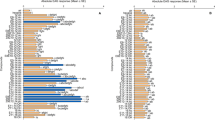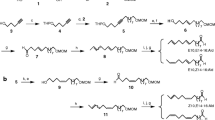Abstract
The composition of the sex pheromone gland of the lightbrown apple moth, Epiphyas postvittana (Walker) was re-investigated. In addition to the two previously identified compounds, (E)-11-tetradecenyl acetate (E11-14Ac) and (E,E)-9,11-tetradecadienyl acetate (E9E11-14Ac), seven additional candidate pheromone compounds were identified: (E)-11-tetradecen-1-ol (E11-14OH), tetradecyl acetate, hexadecanal, (E)-11-hexadecenyl acetate (E11-16Ac), hexadecyl acetate, octadecanal, and octadecyl acetate. Gas chromatographic-electroantennographic detection analysis showed that only four (of the nine) compounds (E11-14OH, E11-14Ac, E9E11-14Ac, and E11-16Ac) elicited electrophysiological responses. When either E11-14OH or E11-16Ac were tested at various ratios in three-component blends with both E11-14Ac and E9E11-14Ac, no increase in trap catch was observed compared to that to the previously identified binary blend. However, when these two compounds (1% E11-14OH and 0.5% E11-16Ac) were both added to E11-14Ac and E9E11-14Ac, trap catch was roughly double that to the previously identified binary blend alone. The new four-component blend should be more sensitive for detecting this economically important insect, especially in low population areas (i.e., in newly invaded habitats). In addition, this new blend may enhance pheromone control of this pest, through approaches such as mating disruption, lure and kill, and mass trapping.





Similar content being viewed by others
References
Bailey, P., Baker, G., and Caon, G. 1996. Field efficacy and persistence of Bacillus thuringiensis var. kurstaki against Epiphyas postvittana (Walker) (Lepidoptera:Tortricidae) in relation to larval behavior on grapevine leaves. Aust. J. Entomol. 35:297–302.
Baker, T. C., Meyer, W., and Roelofs, W. L. 1981. Sex pheromone dosage and blend specificity of response by oriental fruit moth females. Entomol. Exp. Appl. 30:269–279.
Bellas, T. E., Bartell, R. J. and Hill, A. 1983 Identification of two components of the sex pheromone of the moth, Epiphyas postvittana (Lepidoptera, Tortricidae). J. Chem. Ecol. 9:503–511.
El-Sayed, A., Godde, J., Witzgall, P., and Arn, H. 1999. Characterisation of pheromone blend for grapevine moth, Lobesia botrana by using flight track recording. J. Chem. Ecol. 25:389–400.
El-Sayed, A. M., Suckling, D. M., Wearing, C. H., and Byers, J. A. 2006. Potential of mass trapping for long-term pest management and eradication of invasive species. J. Econ. Entomol. 99:1550–1564.
El-Sayed, A. M., Suckling, D. M., Byers, J. A, Jang E. B., and Wearing, C. H. 2009. Potential of “lure and kill” for long-term pest management and eradication of invasive species. J. Econ. Entomol. 102:815–835.
El-Sayed, A. M. 2011. The Pherobase: Database of Insect Pheromones and Semiochemicals. http://www.pherobase.com.
Foster, S. P., and Roelofs, W. L. 1990. Biosynthesis of a monoene and a conjugated diene sex pheromone component of the lightbrown apple moth by D11 desaturation. Experientia. 46:269–273.
Gray, T. G., Slessor, K. N., Grant, G. G., Shepherd, R. F., Holsten, E. H., and Tracey, A. S. 1984. Identification and field testing of pheromone components of Choristoneura orae (Lepidoptera: Tortricidae). Can. Entomol. 116:51–56.
Guerin, P. M., Arn, H., Buser, H. R., and Charmillot, P. J. 1986. Sex pheromones of Adoxophyes orana: Additional components and variability in ratio of (Z)-9- and (Z)-11-tetradecenyl acetate. J. Chem. Ecol. 12:763–771.
Hitchcock, B. 2009. Protecting Australia’s exports: revision of the genus Epiphyas. CRCNPB 2009 Science Exchange meeting 22–24 September 2009, Sunshine Coast, Queensland, Australia.
Horak, M., Whittle, C. P., Bellas, T. E., and Rumbo, E. R. 1988. Pheromone gland components of some Australian tortricids in relation to their taxonomy. J. Chem. Ecol. 14:1163–1175.
Linn, C. E., and Roelofs, W. L. 1983.. Effect of varying proportions of the alcohol component on sex pheromone blend discrimination in male oriental fruit moths. Physiol. Entomol. 8:291–306.
Lo, P. L., Suckling, D. M., Walker, J. T. S., Shaw, P. W., and Burnip, G. M. 2000. Feeding site preferences of leafrollers (Lepidoptera: Tortricidae) on apple trees. N. Z. J. Crop Hortic. Sci. 28:235–43.
Muggleston, S. J., and Foster, S. P. 1989. Sustained-flight tunnel response of male lightbrown apple moth to synthetic sex pheromone. Physiol. Entomol. 14:443–449.
Neal, J. W., Jr., Klun, J. A., Bierl-Leonhardt, B. A., and Schwarz, M. 1982. Female sex pheromone of Choristoneura parallela (Lepidoptera: Tortricidae). Environ. Entomol. 11:893–896.
Sas Institute Inc. 1998. Statview. Cary, North Carolina: SAS Institute Inc.
Scott, P. W. 1995. Techniques and Practice of Chromatography. Marcel Dekker, New York.
Suckling, D. M., and Shaw, P. W. 1992. Conditions that favor mating disruption of Epiphyas postvittana (Lepidoptera: Tortricidae). Env. Ent. 21:949–956.
Suckling, D. M. and Brockerhoff, E. G. 1999. Control of lightbrown apple moth, Epiphyas postvittana (Lepidoptera: Tortricidae) using an attracticide. J. Econ. Entomol. 92:367–372.
Suckling, D. M. and Brockerhoff, E. G. 2010. Invasion biology, ecology, and management of the light brown apple moth (Tortricidae). Annu. Rev. Entomol. 55:285–306.
Wearing, C. H., Thomas, W. P., Dugdale, J. S., and Danthanarayana, W. 1991. Tortricid pests of pome and stone fruits, Australian and New Zealand species. pp. 453–72, in L. van der Geest, H. H. Evenhuis (eds.). Tortricid Pests: Their Biology, Natural Enemies and Control. Elsevier, Amsterdam.
Witzgall, P. 1990. Attraction of Cacoecimorpha pronubana male moths to synthetic sex pheromone blends in the wind tunnel. J. Chem. Ecol. 16:1507–1516.
Witzgall, P., Bengtsson, M., Buser, H. R., Chambon, P. J., Priesner, E., Wildbolz, T., and Arn, H. 1991. Sex pheromones of Spilonota ocellana and Spilonota laricana. Entomol. Exp. Appl. 60:219–223.
Acknowledgements
This work was supported by the New Zealand Foundation for Research Science and Technology (CO6X0811, Sustainable Integrated Pest Management in Horticulture). We thank Messrs Graeme Rogers and Brian Pattchett for allowing us to conduct experiments in their orchards.
Author information
Authors and Affiliations
Corresponding author
Rights and permissions
About this article
Cite this article
El-Sayed, A.M., Mitchell, V.J., Manning, LA.M. et al. New Sex Pheromone Blend for the Lightbrown Apple Moth, Epiphyas postvittana . J Chem Ecol 37, 640–646 (2011). https://doi.org/10.1007/s10886-011-9964-x
Received:
Revised:
Accepted:
Published:
Issue Date:
DOI: https://doi.org/10.1007/s10886-011-9964-x




